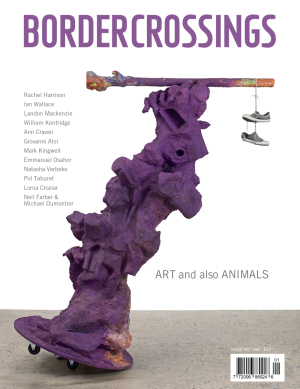“Image and Inscription: An Anthology of Contemporary Canadian Photography,” edited by Robert Bean
The spirit of Image and Inscription: An Anthology of Contemporary Canadian Photography is well summarized by its prefacing quote: “The illiteracy of the future will be ignorance not of reading or writing, but of photography.” On a less theoryheavy note, editor Robert Bean characterizes the book as a “photo album,” a “compilation of photographs, captions, narratives and explanations” proferring a pastiched and subjective set of histories rather than a solely authored, linear one.
Image and Inscription is thus positioned as a book exploring different approaches to photography and photographic interpretation in Canada, giving relatively equal weight both to images and to ways of reading them. Logistically initiated by Gallery 44 to commemorate their 25th anniversary, Image and Inscription’s essays are written by a variety of well-known Canadian curators and critics: Lynne Bell, Jim Drobnick, Robert Enright, Jennifer Fisher, Blake Fitzgerald, Steven Horne, Vid Ingelevics, Marie-Josee Jean, Robin Metcalfe and Carol Williams. Curated artist pages by Cathy Busby, Rosalie Favell, Jeanne Ju, Katherine Knight, Arnaud Maggs, Michael Maranda, Scott McFarland, Alain Paiement, Arthur Renwick and Eve K. Tremblay play off, and echo, these texts.
Sub-themes within the broader mandate of the book vary considerably. Subjects range from assessments of colonialization within Saskatchewan’s archival photographs (Lynne Bell) to praiseful examinations of a single artist (Robert Enright) to examinations of the role of museum photography (Vid Ingelevics) and analyses of the use of allusion in contemporary image-making (Marie-Josee Jean). If this were indeed the photo album of Bean’s appellation, it would be easy to identify some essays as close-ups, others as sweeping landscapes, and others as found photographs. The most successful essays are those that examine, reveal or reconstruct the social and personal histories often suppressed or appropriated by art criticism.
Halifax curator Robin Metcalfe’s delightful piece “Light in the Loafers: The Gay Photographs of Gaëtan Dugas and the Invention of Patient Zero” successfully integrates personal and academic approaches in an intriguing look at the nature of notoriety, creative non-fiction and the AIDS crisis. Using five black and white photos of Gaëtan Dugas, the Air Canada flight attendant who became known as the “Typhoid Mary” of AIDS, Metcalfe takes a memorable trip along themes of queer radicalism, gender roles and swingers of all kinds.
Metcalfe’s disclosure that he himself was taken aback by Dugas’s beauty on a Halifax dance floor is moving, and intentionally so. In Metcalfe’s words, “my own motive in writing this, my addition to the literature of Gaëtan Dugas, is to rescue my experience of two men who have been (to different degrees) known to me—the man in the swing and the man behind the camera—from discursive constructions that tend to eclipse a lived reality.”
In “Nation, Identity, Periphery and Modernity: Synthesizing Canada’s Photographic History,” University of Lethbridge Women’s Studies professor Carol Williams reviews “vexing” attempts to narrate photography’s history, looking to sources on Canada’s northwest coast as an example. Williams’s sensibility is attuned to how localized narratives of photography impede appraisal of politically conscious work, particularly those of women.
Through omission, a few pointed comments and a shift of focus, Williams subtly and overtly critiques the Vancouver School and the position of supremacy that art historians in Canada have accorded them. She barely mentions the school’s famed members, and instead emphasizes the work of Jin-me Yoon and Marian Penner Bancroft, whose “work denies separation of lived experience and artistic output,” upon which photoconceptualists depend.
In her essay “The Post/Colonial Photographic Archive and the Work of Memory,” Lynne Bell looks at the use of photography in creating a different kind of institution, the University of Saskatchewan. Reflecting on official spin-doctoring regarding the province’s centenary and the extensive use of archival images to celebrate same, Bell looks for other readings and representations that reveal the violence of colonization necessary to establishing Eurocentric modes of learning in the Canadian West. She points to the art of Gerald McMaster and Dana Claxton in particular as examples of work that can “undo the colonial archive.” This essay examines not only the myth one archive offers, but also practices for unseating that myth—a challenging and necessary task.
While essays form the meat of the book, the artist pages seem selected to resound with the themes raised. Eve K. Tremblay’s “Tales Without Grounds,” a series of mysterious portraits set in a hydroponic greenhouse, registers as both a critique of industry and a representation of personal loneliness. Rosalie Favell’s works on Native women’s identities smartly reclaim and reframe classic stereotypes. And Jeanne Ju’s “Art Stars” series ends the book on a self-reflexive note, providing both People-style gossip fodder and prods for deconstructing current systems of art marketing and production—systems of which Image and Inscription is inevitably a part.
Overall, Image and Inscription excels as the “photo album” that Bean references. Yet, I wonder if it wouldn’t be more appropriately categorized as a yearbook, a record of time spent loosely together in the lanky, awkward, gifted-kid high school of Canadian art. (Disclosure: Perhaps it’s because Bean was once my teacher and Ju my classmate that I feel this way.) The design of this book is fantastic, but for one exception— next time they should leave some room for autographs. ■
Image and Inscription: An Anthology of Contemporary Canadian Photography, edited by Robert Bean, YYZ Books and Gallery 44 Centre for Contemporary Photography, 2006, softcover, 240 pp, $39.95.
Leah Sandals is a freelance writer based in Toronto.

